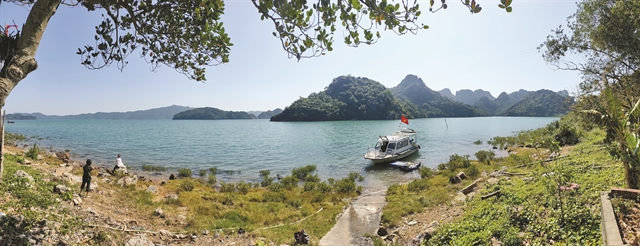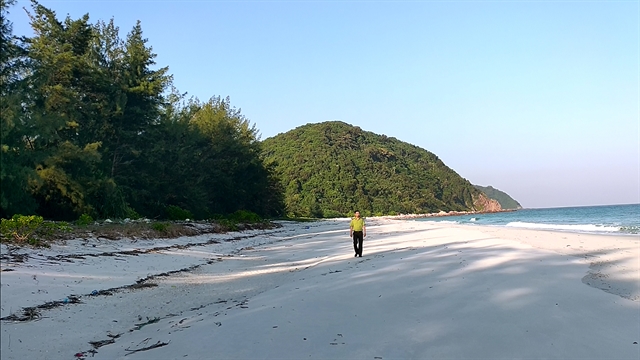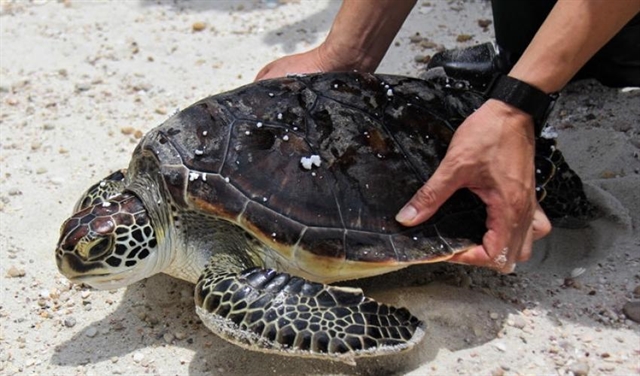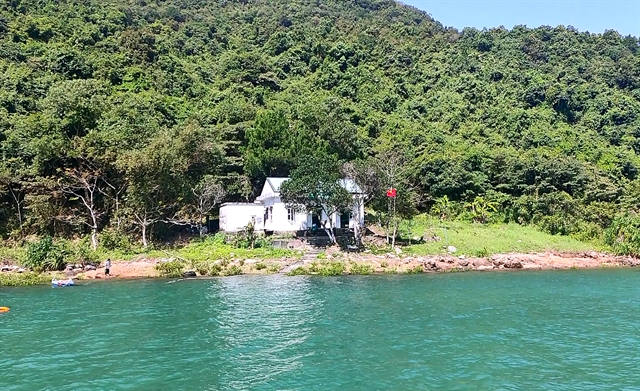 Features
Features

Rangers at Bái Tử Long National Conservation Park dedicated to preserving its natural beauty and flora and fauna
Rangers at Bái Tử Long National Conservation Park dedicated to preserving its natural beauty and flora and fauna

|
| OUT OF REACH: Cái Lim Island in Bái Tử Long Bay has no mobile phone signal at all. VNS Photos Đoàn Tùng |
by Nguyễn Mỹ Hà
Now that the summer holiday season has officially ended, the beaches of Quan Lạn Island are starting to return to their usual tranquil state, but there is so much garbage still onshore.
Of Việt Nam’s many beautiful beaches, pristine and secluded stretches on tiny islands in Hạ Long Bay, Lan Hạ Bay and Bái Tử Long Bay off the coast of the northern province of Quảng Ninh would fight it out with Minh Châu on Quan Lạn Island in Bái Tử Long for bragging rights.
The turquoise waters and soft white sand of untouched beaches on Quan Lạn Island are perhaps only rivalled by Sao Beach on Phú Quốc Island in the country’s south.
But they have been blighted by tonnes of garbage, including bottles, cardboard, flip-flops, and plastic toys, that have washed ashore.
Turtle Beach

|
| LAND MEETS SEA: The white sand and crystal clear waters of Minh Châu Beach on Quan Lạn Island. |
In the summer, local holidaymakers tend to visit the larger beach, Minh Châu, but only 2km away is another beach where sea turtles used to come to lay their eggs.
“They stopped coming about ten years ago,” lamented Phạm Quốc Việt, deputy head of the Scientific Research and International Cooperation Department at the Bái Tử Long National Conservation Park.
Inaccessible by motorbike and separated from the main road by casuarina trees planted five years ago, local park rangers have been trying to return the beach to its former health so that the turtles may return.
“We have put up signs forbidding people from bathing at Turtle Beach,” Nguyễn Đình Ưng, deputy head of the forest rangers at the park, said.
The beach actually has rough waves and can be quite dangerous, with an under-current taking unsuspecting swimmers out to sea.
“Even if you can swim, without a lifebuoy you’re likely to be swept out,” Ưng said.

|
Two years ago, an art project using garbage was introduced at Minh Châu Beach by the International Union for the Conservation of Nature (IUCN) -- the London-based international union of governments and civil society groups that has 1,400 members and more than 17,000 experts worldwide.
“One man’s trash is another man’s treasure” is the theme of the art camp, which brings together artists who create works using the garbage collected from the beach.
But there were no art works the day we were there, only garbage. “It keeps washing ashore,” local people told us.

|
| EYE-SORE: A large amount of garbage washed ashore on beautiful Minh Châu Beach on Quan Lạn Island after the summer holiday season was over. VNS Photo Mỹ Hà |
We’d always thought that when the holiday season ends and the beach becomes clean that it stays that way until the following summer arrives.
Quan Lạn Island, located in the heart of the Bái Tử Long National Conservation Park, is a tourist destination that welcomes some 50,000 visitors each year. Its beaches are largely undeveloped, with the only accommodation being small homestays.
But the amount of garbage on the island is certainly not small, though no public figures have ever been released. The island is still waiting for waste collection and treatment facilities.
Genetic pool

|
| GREEN SCENES: Rangers patrolling the ironwood forest from which Cái Lim Island gets its name. |
Founded in 2001, the Bái Tử Long National Conservation Park will celebrate its 20th birthday next year. Its emblem includes an image of a dolphin. The mammals inhabit the bay, though very few people have caught sight of them.
“Seeing them is down to sheer luck,” Việt said. “I’ve worked here for ten years and never seen them. But the deputy head of the park, on his first trip out to Ba Mùn Island many years ago to visit rangers, was greeted by a school of dolphins.”
From the wharf in Vân Đồn, a motorised boat ride of 45 minutes took us to a big earthen island.
“Ba Mùn Island is the beating heart of biological diversity in Bái Tử Long Park, as is home to signature flora and fauna,” Việt said,
“The most significant wild animals in the island’s forest are a community of wild deer,” he went on, but added that no camera-trap images exist and little is known about the creatures. The only image is a video of a deer swimming from Ba Mùn to another island.
“I think the good management of wild animals has actually put us in more danger when we go out on patrols,” said Nguyễn Hải Phong, a young forest ranger on Ba Mùn.
He once came across a giant cobra trying to shed its skin. A few years earlier, a two-man patrol was attacked by a wild boar. The younger ranger jumped up into a tree and narrowly escaped, but the older ranger was bitten on the arm, which severed an artery, and he was rushed to hospital in Hà Nội for treatment.

|
| OCEANFRONT VIEWS: The rangers’ house on Cái Lim Island, which looks out over a beautiful mixture of blue, green and turquoise water. |
Wild forests elsewhere in Bái Tử Long have also been revived.
While on Cái Lim Island with Việt, he told us it is home to a strong bed of green ironwood trees. Named after the trees that dominate the island, Cái Lim is only accessible by boat and a phone signal is rare. You’re pretty much cut off from the outside world.
“The park has significant marine biodiversity,” said Việt, who graduated from the country’s leading Nha Trang Maritime University in marine research. He is also one of seven certified divers at the park, and conducts regular inspections both on land and underwater.
“Last year, we found a new type of branch coral reef when diving around Mang Khơi Island,” he told us. “Scientists say this type of coral is one of the fastest-growing in the world, by 15cm a year.”
After the discovery was reported to the park authority, a strict protection zone was initiated to protect the coral.
The Bái Tử Long National Conservation Park boasts six ecosystems, including an evergreen forest on an earthen island, an evergreen forest on a limestone karst, mangrove forests, coral reefs, the Tùng-Áng ecosystem, and a marine vegetation ecosystem.
Tùng-Áng are collapsed sinkholes in underwater mountains. “The flora and fauna have been fully protected from human interference since they were found,” Việt said.
The park has two types of sinkholes, or dolines: one with a gate to the outer sea, and another with underwater currents and caves.
“Cái Đé Doline is the largest in the park, at 26ha,” he told us. “There’s a whole mangrove forest in the area.”
“This is the best conservation park we have for preserving all creatures and keeping humans away.”
Scientific research has revealed that the 391 species of marine structures here provide a large genetic pool for further studies. Seventeen coral species, noted as under threat of extinction in the Việt Nam Red Book of Endangered Species, have also been found in the area.
Conservation work

|
| LIFE UNDERWATER: At a museum on the park in Vân Đồn District are exhibits of living creatures from the seas. |
While Turtle Beach on Quan Lạn Island is in desperate need of a regular clean-up if it is to once again be the natural habitat of turtles laying their eggs, the island’s forests have been quite well preserved, so much so that rangers need to be alert while on patrol.
“We hope to get one more patrol boat to add to our fleet,” said Ưng, who spent 42 years as a ranger. On a recent late-night inspection on Ba Mùn Island, he broke his left leg in an incident.
“A new regulation that came into being last year states that rangers must try and stop any violations of marine areas or forests and hand over suspects to local authorities or border guards. We are unable to issue our own administrative punishment to violators.”
To complete administrative and archiving work in the rangers’ office, which is an important task, more computers are required, according to Ưng.
Việt, meanwhile, said the department needed a lot more equipment to monitor the flora and fauna they are charged with protecting.
“We don’t have a flycam to shoot images from above,” he said. “And our camera traps all broke a long time ago.”
He can shoot underwater footage while on diving patrols, but the quality is limited.
Next year, when the park celebrates its 20th anniversary, Ưng plans to retire after a long career as a ranger. The young diver-scientist, Việt, hopes to continue preserving natural resources and keeping the environment safe.
“I also hope we can introduce eco-tourism, to earn some revenue for reinvesting in costly preservation work,” he said.
As for young forest ranger Phong, he hopes to celebrate his wedding by the dock on Cái Mùn Island.
He also plans to bring his future in-laws to where he works, so they will understand why he is away from home for so long protecting the wildlife for his children’s children to admire. VNS




